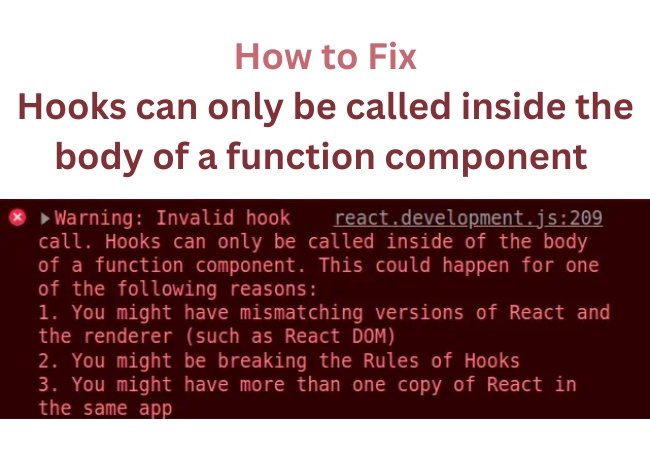Contents
React Hooks
React Hooks have revolutionized the way we write components in React, enabling us to manage state and side effects more elegantly.
However, one common mistake that React developers encounter is the error message “Hooks can only be called inside the body of a function component.”
In this blog post, we’ll explore the scenarios that can cause this error and provide practical solutions to resolve it.
Understanding the Error
Before diving into the examples, let’s briefly understand why this error occurs. React Hooks, such as useState, useEffect, useContext, etc., are meant to be used only within functional components.
If you try to use them in a non-functional component or outside the component’s body, React will raise the “Hooks can only be called inside the body of a function component” error.
There are three prevalent reasons why you may encounter this issue:
- The versions of React and React DOM in your project may not be compatible or might be mismatched.
- It’s possible that you’re violating the Rules of Hooks in your code.
- There could be multiple instances of React present within the same application.
Incorrect Version of React
You could be utilizing a version of react-dom (< 16.8.0) or react-native (< 0.59) that doesn’t have support for Hooks. To determine the version you are currently using, run npm ls react-dom or npm ls react-native in your application directory. If you discover multiple instances of these packages, it could potentially lead to issues (explained further below).
Violating the Rules of Hooks
Hooks in React can only be invoked while rendering a function component. Ensure proper usage by following these guidelines:
Call Hooks at the top level within the body of a function component.
Call Hooks at the top level within the body of a custom Hook.
To prevent confusion and potential errors, refrain from calling Hooks in the following cases:
Avoid calling Hooks in class components.
Avoid calling Hooks in event handlers.
Avoid calling Hooks inside functions passed to useMemo, useReducer, or useEffect.
Failure to adhere to these guidelines may result in errors.
Keep in mind that Custom Hooks can call other Hooks as it aligns with their purpose, but they should still be invoked only during the rendering of a function component.
Example 1: Incorrect Usage of Hooks
import React from 'react';
class MyComponent extends React.Component {
useEffect(() => {
// Some side effect
}, []);
render() {
return <div>My Component</div>;
}
}
In the example above, we’ve attempted to use the useEffect hook inside a class component, which is not allowed. This will trigger the “Hooks can only be called inside the body of a function component” error.
Example 2: Incorrect Placement of Hooks
import React, { useState } from 'react';
const MyComponent = () => {
if (someCondition) {
useState(0); // Invalid placement of useState hook
}
return <div>My Component</div>;
};
In this case, we’ve placed the useState hook inside an if statement, which is outside the main body of the functional component. As a result, React will throw the same error.
Hooks in Nested Functions
Issue: Defining hooks inside nested functions can lead to the error.
Solution: Move the hook calls to the top level of your function component.
function MyComponent() {
function nestedFunction() {
// This will cause an error
const [state, setState] = useState(initialValue);
}
// Move hook calls to the top level
const [state, setState] = useState(initialValue);
// ...
}
Destructuring Inside Render
Issue: Destructuring hooks inside the render can cause the error.
Solution: Destructure the hooks outside the render function.
// Incorrect
function MyComponent() {
const { value, setValue } = useState(initialValue);
// ...
return <div>{value}</div>;
}
// Correct
function MyComponent() {
const [value, setValue] = useState(initialValue);
// ...
return <div>{value}</div>;
}
Hooks in Event Handlers
Issue: Using hooks directly in event handlers can lead to issues.
Solution: Use useCallback or wrap the event handler in a function to avoid stale closures.
function MyComponent() {
const [count, setCount] = useState(0);
// Incorrect
const handleClick = () => {
// This will capture the initial value of count
setCount(count + 1);
};
// Correct
const handleClick = useCallback(() => {
// This will use the latest value of count
setCount((prevCount) => prevCount + 1);
}, [setCount]);
return <button onClick={handleClick}>Increment</button>;
}
Resolving the Error
Now that we understand what triggers the “Hooks can only be called inside the body of a function component” error, let’s explore the correct way to use hooks in React.
1. Use Hooks within Functional Components
Make sure that you use hooks only inside functional components and not inside class components or outside the component body. If you need to access state or perform side effects, switch your class components to functional components and leverage hooks to manage the state and side effects.
Corrected Example
import React, { useEffect } from 'react';
const MyComponent = () => {
useEffect(() => {
// Some side effect
}, []);
return <div>My Component</div>;
};
2. Conditionally Apply Hooks
If you need to conditionally use a hook, do it at the top level of the functional component. Hooks must be called unconditionally in every render, so you should not place them inside conditions, loops, or nested functions.
Corrected Example
import React, { useState } from 'react';
const MyComponent = () => {
const [count, setCount] = useState(0);
if (someCondition) {
// Do something
}
return (
<div>
<p>Count: {count}</p>
<button onClick={() => setCount(count + 1)}>Increment</button>
</div>
);
};
Issue: Using hooks conditionally might cause the error if the hook is not called on every render.
Solution: Ensure that hooks are called unconditionally on every render, and consider using the useState or useEffect hook inside the conditional block.
function MyComponent() {
if (condition) {
// This will cause an error if condition is false
const [state, setState] = useState(initialValue);
}
// ...
}
3. Use Hooks with Custom Hooks
If you have reusable state logic or side effects, consider encapsulating them in custom hooks and using those hooks inside functional components. Custom hooks allow you to extract complex logic and reuse it across different components.
Custom Hook Example
import { useState, useEffect } from 'react';
const useCounter = () => {
const [count, setCount] = useState(0);
useEffect(() => {
// Some side effect
}, [count]);
return [count, setCount];
};
export default useCounter;
Using the Custom Hook
import React from 'react';
import useCounter from './useCounter';
const MyComponent = () => {
const [count, setCount] = useCounter();
return (
<div>
<p>Count: {count}</p>
<button onClick={() => setCount(count + 1)}>Increment</button>
</div>
);
};
Conclusion
Understanding how to use React Hooks properly is essential to avoid common pitfalls and errors.
In this blog post, we explored why the “Hooks can only be called inside the body of a function component” error occurs and provided practical solutions to resolve it.
By following the correct usage of hooks within functional components and considering custom hooks for reusable logic, you can harness the full power of React Hooks in your applications and create more maintainable and scalable code.
Remember to always refer to the React documentation and community resources to stay up-to-date with best practices and emerging patterns.
Happy coding!





0 Comments